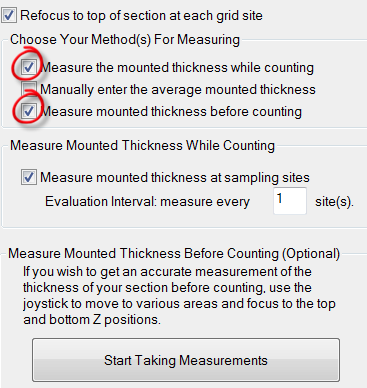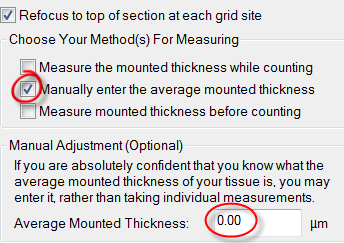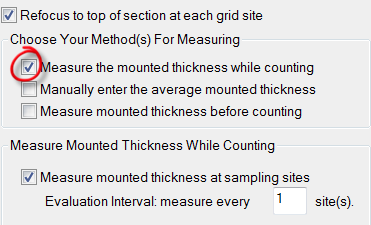Measure mounted thickness
Spaceballs - step 5
The estimates for Spaceballs use the measured post-processing thickness of the tissue. The results will vary depending on the measuring method you use.
We recommend that you measure the tissue thickness at every sampling site for the most accurate estimates.
Preferred method
- Select Measure the mounted thickness while counting.
- Set the Evaluation Interval to 1.
For some studies, researchers may choose to measure the section thickness at every 3rd sampling site (i.e., Evaluation Interval=3) to save time. It is acceptable if the thickness of the sections is uniform.
Refocus to top of section at each grid site
Recommended when the tissue is wavy.
Choose your method(s) for measuring
| Method(s) | How to use |

|
To take measurements in this step (i.e., before counting):
The Evaluation Interval is set to "1" by default. If thickness is uniform across sections, increasing the Evaluation Interval will save some time, but we still recommend measuring the thickness at every site to increase the accuracy of the estimates. Used to calculate Estimated population using mean section thickness, Estimated population using mean section thickness(only using sites with counts), Estimated population using number weighted section thickness (see Spaceballs step 10: View the results).
|
|
|
The Evaluation Interval is set to 1 by default. If thickness is uniform across sections, you can increase the Evaluation Interval to be more efficient, but we still recommend measuring the thickness at every site to increase the accuracy of the estimates. Used to calculate Estimated population using mean section thickness, Estimated population using mean section thickness(only using sites with counts), Estimated population using number weighted section thickness (see Spaceballs step 10: View the results). |

|
When you already know the average mounted thickness and when the thickness is uniform. This method saves time while counting, but can result in inaccurate estimates, especially if your tissue is somewhat wavy. Used to calculate Estimated population using user-defined section thickness (see Spaceballs step 10: View the results). |
